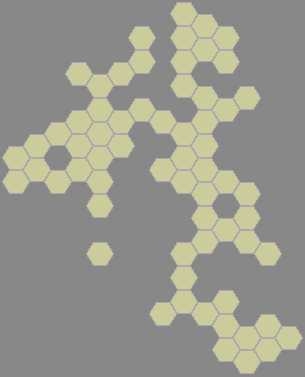China Tangle is a game using 63 of the 64 hexagonal tiles of a two-groups transcendental solution of the China Labyrinth as a board.

|
Material On the left you can see such a solution. It was generated by the China Tangle app. For completeness the one tile that is always disconnected in a transcendental solution has been added to the picture, but it plays no role in the game. Both players have a sufficient number of checkers, one player having white, the other black. Definitions The China Labyrinth has hexagons with every possible number and pattern of exits, in all possible rotations and reflections, without identical doubles. China Tangle's main variant is played pattern based but there's an additional option to play it number based, as explained below.
|
Rules
- The game starts on an empty board, White plays first, Black is entitled to a swap.
- If a player on his turn puts one checker on a vacant cell, then all vacant cells that are open to further placements in the same turn are highlighted. In pattern mode these are cells with the same pattern of exits as the cell of the first checker that is placed, including all possible rotations and reflections.
- The maximum number of checkers a player may place, if possible, equals 7 minus the number of exits of the cell on which the first checker is placed. A player may place less than the number he's entitled to place. This is particularly important with the very first move, which is a swap offer.
Obviously only one checker can be placed on the one cell with six exits. But place the first checker on a cell with one exit, then you can place six checkers, provided all six cells with one exit are vacant. It will not always be possible to place checkers up to the theoretical limit. This holds especially in pattern mode.
Goal
The game ends when the board is full, or earlier if a player resigns. On a full board the players' groups are compared, and the player with the largest group is te winner. If the players' largest groups are of equal size, then these two groups are out of competition and the next largest groups are compared (which may be the same size for one or both colours), and so on. Because the playing area has an odd number of cells the count is cascading down to an inevitable decision.
Number mode
In number mode the app will every turn highlight all vacant cells with the same number of exits as the cell on which the first checker is placed, regardless of patterns, as possible follow up placement options in the same turn. All else is the same.
Note that for cells with one neighbour cell or with five, there is no difference between number mode and pattern mode.
Play China Tangle interactively
How I invented ... China Tangle
And now for something completely different
China Tangle © MindSports
